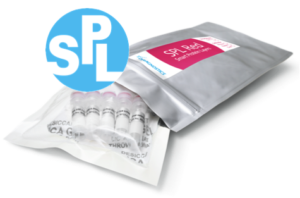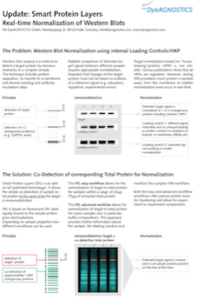SPL Smart Protein Layers
Kit zur einfachen Normalisierung von Western Blots
Der SPL Kit ermöglicht den einfachen, aber sehr genauen Nachweis wieviel Gesamtprotein einer Probe zum Zeitpunkt der Targetdetektion auf der Blotmembran vorhanden ist. Durch das Verhältnis von Targetsignal zu seinem korrespondieren Gesamtprotein erfolgt die exakte Normalisierung. Eine Anfärbung der Membran oder der quantitative Nachweis endogener Proteine (house-keeping proteins) entfällt damit.
.
SPL Features
- • hoch-sensitive Proteinvisualisierung von Gelen und Blots ohne Färben
- • einfache, aber genaue Normalisierung von Western Blots
weitere Features mit zusätzlichen SPL Standards
- • Beladung von Proben ohne Proteinbestimmung
- • Überwachung jedes Schrittes der Western Blot Analyse
- • Vorlage zur präzisen Quantifizierung von Target-Signalen
- • exakte Vergleiche von Daten verschiedener Experimente
.
Wie funktioniert SPL?
Die Proteinprobe wird vor der Elektrophorese durch Zugabe von fluoreszierenden Smart Labels markiert. Die nun fluoreszierenden Proteine können damit im Gel und auf dem Blot nachgewiesen werden (ca. 100x sensitiver als z.B. Coomassie). Für die präzise Normalisierung von Western Blots wird wie gewohnt a) die Menge an Targetsignal nachgewiesen (z.B. über fluoreszierende Sekundärantikörper oder ECL) und b) die zu diesem Zeitpunkt auf dem Blot befindliche Menge an Probe (Gesamtprotein) detektiert.
.
Warum gibt es verschiedene SPL Kits?
In Abhängigkeit Ihrer Art des Targetnachweises und Ihrer Möglichkeit des Fluoreszenz-Imagings, bieten wir verschiedene SPL Kits zur Visualisierung des Gesamtproteins an.
SPL Kits
| Product No. | Description | Size | Recommended
Target Detection |
Required
Fluorescence Imaging |
Price |
| PR913 |
SPL Red Kit 20W
|
200 rcts. | Immuno Blue
or ECL |
blue + red | 179,00 EUR |
| PR926 |
SPL Red Kit 40W
|
400 rcts. | Immuno Blue
or ECL |
blue + red | 329,00 EUR |
| PR916 |
SPL Blue Kit 20W
|
200 rcts. | Red-fluoresc. AB
|
blue + red | 179,00 EUR |
| PR925 |
SPL Blue Kit 40W
|
400 rcts. | Red-fluoresc. AB
|
blue + red | 329,00 EUR |
| PR917 |
SPL Red-IR Kit 20W
|
200 rcts. | IR-fluoresc. AB
or ECL |
red + IR | 179,00 EUR |
| PR927 |
SPL Red-IR Kit 40W
|
400 rcts. | IR-fluoresc. AB
or ECL |
red + IR | 329,00 EUR |
.
SPL Technology
Die Nutzung mehrerer Wellenlängen für mehr Informationen, dies ist der Hintergrund der patentierten SPL Smart Protein Layers Technolgie. Das wichtigste "mehr" an Western Blot relevanter Information ist, wieviel Probe sich zu dem Zeitpunkt noch auf dem Blot befindet, wenn Sie immunochemisch ein bestimmtes Protein (Target) aus dieser Probe nachweisen. Denn nur so können Sie sicherstellen, dass die detektierten Mengen an Targets tatsächlich miteinander verglichen werden können, weil die Mengen an abundanter Gesamtproteinmenge ebenfalls vergleichbar (bzw. aufeinander normalisierbar) sind.
Aber auch eine Vielzahl von Informationen wie der tatsächliche Proteingehalt einer Probe, die auf das Gel geladene Menge aber auch das Wissen um die heutige Performance Ihres 2ten Antikörpers spielen bei Western Blots eine wichtige Rolle.
Dabei basiert die SPL Smart Protein Layers Technologie auf dem Zusammenspiel von fluoreszierenden Kontrollstandards (Smartalyzer) und einer schnellen und kontrollierten Markierung der Proben und des Smartalyzers mit speziellen Fluorophoren.
.
WB Normalization using "House-keeping proteins"
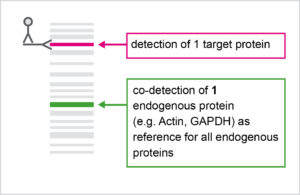
.
WB Normalization using SPL
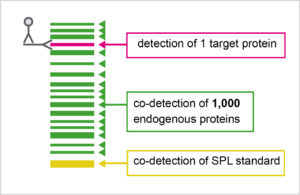
Der SPL Kit besteht aus drei Komponenten:
- • Der Smartalyzer befindet sich im SPL Ladepuffer und wird der Probe in definierte Menge zugegeben. Er ist ein spezifischer Standard für die exakte Normaliserung and Quantifizierung der Probe in Protein-Gelen und Western Blots.
- • Fluoreszierende Smart Label werden nach Zugabe des SPL Ladepuffers der Probe zugegeben. Durch eine einfache, schnelle und robuste Bindung dieser Fluorophore an die Proteinprobe (5min bei 37 bis 95 Grad C) sowie an den Smartalyzer, können die Proteine während/ nach der Gelelektrophorese und während der gesamten Western Blot Analyse in höchster Sensitivität detektiert werden.
- • Der Calibrator ist ein Gel- und Blot-spezifischer Standard, der den Gel- und Blot-übergreifenden Datenvergleich (Quantifizierung) ermöglicht. Der Calibrator ist zumdem eine fluoreszierende Molekulargewichtsleiter.
Nutzen
- • Zeitgleiche Normalisierung eines Western Blot Targetprotein auf ca. 800 -1000 korrespondierende Probenproteine
Zusatznutzen
- • färbungsfreie Proteindetektion
(Sensitivität von Silber, jedoch 1000x höhere Dynamic) - • Protein Load Equalizer
(Normalisierung von Proben mit ungleichem Proteingehalt/ Probenauftrag) - • präzise Quantifizierung der Targetexpression
(präzise Spur-zu-Spur und Blot-zu-Blot Vergleiche)
.
Related Documents
Publikationen
Rausche J, Stenzel I, Stauder R et al. A phosphoinositide 5‐phosphatase from Solanum tuberosum is activated by PAMP‐treatment and may antagonize phosphatidylinositol 4,5‐bisphosphate at Phytophthora infestans infection sites. New Phytol. 2020, doi:10.1111/nph.16853
Weitere Publikationen und Referenzen finden Sie hier.
Manuals
PDF Quick Guide SPL Markierung (Kurzanleitung für die Laborbank)
.
PDF Manual PR916/PR925 SPL Blue Kit 20W / 40W deu
.
PDF Manual PR913/PR926 SPL Red Kit 20W / 40W deu
.
PDF Manual PR917/PR927 SPL Red-IR Kit 20W / 40W deu
Sicherheitsdatenblatt
PDF Sicherheitsdatenblatt PR917/PR927 SPL Kits für Western Blots
.
Standard for Blot-to-Blot Comparison
Calibrator B
The Calibrator B (50 kDa, either mouse, rabbit or goat) is specific to secondary antibody (either anti-mouse, anti-rabbit or anti-goat). Cal B therefore allows to check for the performance of the secondary AB. Furthermore, when applied to the blot, Cal B allows for precise blot-to-blot analysis by normalization of secondary AB signal intensities.
The kit contains 1 vial Cal B sufficient for 20 Western Blot experiments (1D) or 10 2D-Western Blots.
.
| Product No. | Description | Price |
| PR921 | Calibrator B
Mouse |
50,00 EUR |
| PR922 | Calibrator B
Rabbit |
50,00 EUR |
| PR923 | Calibrator B
Goat |
50,00 EUR |
.
.
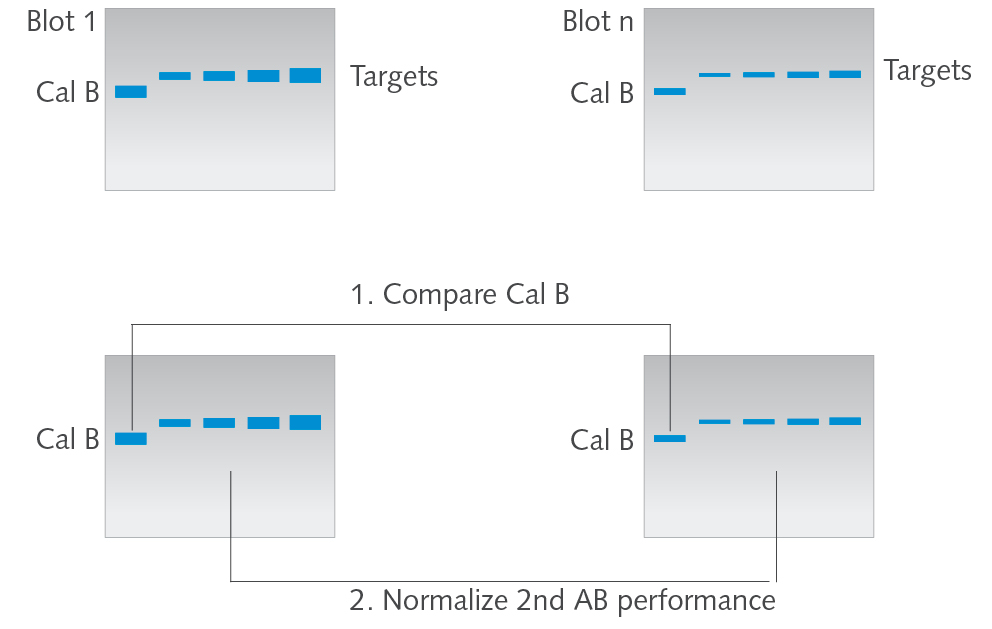
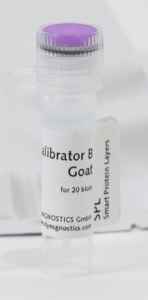
.
Frequently asked questions (FAQs)
.
Does the SPL labels interfere with antibody recognition?
The SPL technology uses the labeling chemistry of the so-called minimal lysine labeling. Only 2-3% of each protein is getting labeled with one fluorophore per protein. A lysine-residue important for antibody recognition can be conjugated with fluorophore leading to antibody interference. However, since 97-98% of this protein is not labeled, it does not matter.
Do differences in sample labeling efficiency lead to false protein detection signals?
The minimal labeling chemistry was originally developed for purified protein samples for 2D gel analysis (Refraction-2D, 2D-DIGE). For 1D gel analysis and Western Blots the protein preparation is more crude: proteins are extracted from proteins and, after the addition of loading buffer separated by SDS-PAGE.However, not purified protein samples may contain components leading to a decrease in labeling efficiency as this is a chemical reaction. Special compounds in the SPL loading buffer ensure optimal labeling conditions for most samples. In addition, the efficiency of the SPL labeling of each sample is carefully monitored and if necessary normalized by the control standard (the Smartalyzer, patented technology).
What is the difference between a (fluorescent) stain and a Smart Label?
A stain is a dye binding non-covalently to proteins. The staining procedure includes the staining and than several destaining steps. The reproducibility of stains is related to the staining efficiency (e.g. time, temperature) and may suffer from background.
Smart Labels are fluorescent dyes, which bind covalently to proteins. Smart labeled proteins can be visualized directly after electrophoresis – no staining or destaining steps are required. Smart Labels are highly sensitive with a wide dynamic range.
.
Is the Smart Labeling exclusive for certain proteins or will it favor certain proteins?
Smart Labels bind to all proteins in a non-saturated way to allow for precise quantification. The labeling chemistry and ratio of labels to proteins are well established (see more than 1,000 DIGE and Refraction-2D publications) and guarantees an even labeling of all proteins within one sample.
.
What may inhibit the labeling process?
Due to special SPL buffers, the Smart Label reaction is very robust. Smart Labeling is compatible with all commonly used buffer systems. However, high concentrations of reducing agents (> 15 mM DTT or > 10 % beta-mercaptoethanol) and amines > 400 mM may interfere with labeling reaction. The SPL Smartalyzer (SMA) is added to the labeling reaction as a control. Its unique design monitors labeling efficiency and if necessary compensates for unequal labeling.
.
For sample Smart Labeling, what is the maximum and minimum volume of my sample? The maximum volume is 10 µl per Smart Label reaction (containing up to 100 µg of protein). The minimum volume is only given by what you can still handle.
.
If I have to dilute my protein sample before Smart Labeling, can I use my own buffer? Yes please.
.
Why is the Smartalyzer (SMA) bi-fluorescent?
The SMA itself is mono-fluorescent (e.g. SMA basic blue). SMA is added to the protein sample before Smart Labeling. SMA is labeled together with the protein sample (e.g. with Smart Label Red). So SMA becomes bi-fluorescent (e.g. basic blue and label red). SMA basic allows for normalization of gel loading and SMA Label allows for normalization of labeling.
.
Which size of the standard SMA should I use, 12.5 kDa or 80 kDa?
The size of the SMA should differ from the size of your target protein and highly abundant proteins within your sample.
.
How do I avoid that the SMA size S (12.5 kDa) runs out of the gel?
Stop electrophoresis before the dye front runs out of the gel. Cut the dye front manually before fluorescence imaging (dye front may interfere with Imaging).
.
Does the Smart Label interfere with subsequent Mass Spectrometry?
No. Smart Labels do not effect enzymatic digestions nor sequence coverage.
.
Does the Smart Label interfere with antibody recognition?
No. Only one amino acid of a minimal amount of protein is labeled.
.
Can I stain Smart labeled gels and then cut out bands?
Yes. Smart Labels are compatible with all commonly visual protein stains (e.g. Coomassie® or silver nitrate) and subsequent protein identification by mass spectrometry.
.
SPL User



